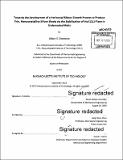Towards the development of a horizontal ribbon growth process to produce thin, monocrystalline silicon sheets via the stabilization of the (111) plane in undercooled melts
Author(s)
Greenlee, Alison S
DownloadFull printable version (23.85Mb)
Other Contributors
Massachusetts Institute of Technology. Department of Mechanical Engineering.
Advisor
Jung-Hoon Chun.
Terms of use
Metadata
Show full item recordAbstract
A new manufacturing process that directly produces thin, monocrystalline silicon wafers would significantly reduce the cost and energy used to make high efficiency, crystalline-silicon solar panels. Although alternative silicon wafer manufacturing processes have been pursued for decades, only the Horizontal Ribbon Growth (HRG) process has ever demonstrated monocrystalline silicon ribbons. Unfortunately, these ribbons have been too thick for commercial use and the HRG process model cannot explain either its inability to produce thin ribbons or what conditions destabilize this process at high pull rates. This work therefore develops a new understanding of how the HRG process stably grows monocrystalline silicon ribbons and investigates a new approach to overcome its inherent process limitations. This work develops the first analytical thermal model of the HRG process that consistently predicts the conditions that destabilize the process and the final ribbon thickness. For the HRG process parameters reported by Kellerman, this model calculates that 25-55% of the latent heat generated at the leading-edge solidification interface can stably dissipate through the undercooled liquid ahead of the interface. These results support Kellerman's theory that the HRG ribbon's leading-edge solidification interface is stabilized by the growth kinetics of the (111) plane. Process windows made from this model reveal the HRG process's inherent limitations in producing thin ribbons, which necessitates a new approach for growing monocrystalline silicon ribbons. This work develops a new approach for growing monocrystalline silicon ribbons where an angled (111) leading-edge solidification interface propagates in a defined silicon film. This involves designing and constructing a high temperature semiconductor demonstration furnace that melts, seeds, and solidifies a silicon film by rapidly extracting heat from the ribbon surface with a helium jet at rates up to 92 W/cm2 . This work develops a fine-gauge thermocouple apparatus that directly measures the temperature profile of a silicon film's solidification interface as it travels through this furnace. Measured temperature profiles of the thin silicon film's solidification interface show predicted high levels of undercooling in the liquid ahead of the interface. This work presents the silicon seeds grown in the demonstration furnace and outlines next steps to enable stable monocrystalline growth.
Description
Thesis: Ph. D., Massachusetts Institute of Technology, Department of Mechanical Engineering, 2015. Cataloged from PDF version of thesis. Includes bibliographical references.
Date issued
2015Department
Massachusetts Institute of Technology. Department of Mechanical EngineeringPublisher
Massachusetts Institute of Technology
Keywords
Mechanical Engineering.